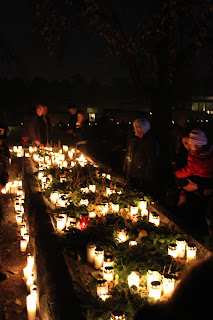November 5th was a holiday here in Sweden called Allhelgonahelg, All Saints. Here's a summary of what All Saints Day is all about:
While the saints of the Christian church have been celebrated on this day since the 8th century - when the sheer quantity of saints made it impossible for each to have his or her own day - Lutheran churches have used the day to remember the dead.We celebrated All Saints at the UNESCO World Heritage Site, Skogskyrkogården. I was not very excited about this holiday, it seemed a little bit strange to me to visit a cemetery where I felt no connection. But we went with Lisa, Olov, and Jane and I'm so glad we did. It was a really great experience and all the candles were so overwhelmingly beautiful and yet very somber. The Swedes do not talk about death or afterlife, it's a very taboo subject and yet they have a holiday specifically to reflect on mortality. This is definitely a worth while activity to partake in when in Sweden. Dale and I might even try to import it to the States, who knows! Anyway, here are my pictures from this years All Saints Day, including one really cute one of little Jane admiring Greta Garbo's grave.
The day is more commonly celebrated in Catholic countries, but the grip the tradition has on the Swedish is firm.
For many, Friday is a half day and on Saturday morning the main newspapers are not printed. As dusk falls on Saturday, All Saints Day, Swedes stream towards the country's graveyards armed with candles, matches, wreaths and flowers for the graves of their loved ones.
The beauty of the candlelight blended with a soothing melancholy creates an emotionally-charged atmosphere. Small rural churchyards are visible across fields, dotted with flecks of golden light, while in towns and cities people murmur hushed greetings to those visiting neighbouring graves.
Probably the most spectacular place to witness the festival is the massive cemetery of Skogskyrkogården in the south of Stockholm. Chatty crowds drift from the train station, past hot dog vendors and candle stalls, as if to a football match.
But as they enter the cemetery they are greeted not with the roar of a stadium but with a silence almost as overwhelming. Thousands upon thousands of marshal lights line the winding road into the churchyard, the glare becoming more and more intense until at the top of the hill in the centre there is barely space to walk between the rows of candles.
It is an awe-inspiring sight, but here and there real mourners, perhaps remembering a loved one for the first time, are a reminder of the day's meaning.
Despite the ancient origins of the festival itself, the tradition of lighting a candle is relatively recent. It began only in the early 1900s and it was not until after the Second World War that it became a national activity.
Today, it is more popular than ever, perhaps reflecting a desire among Swedes to maintain their ties with the past in a fast-changing world. (Source: http://www.thelocal.se/2427/20101105/)
Love Always,
Matilda








0 comments:
Post a Comment